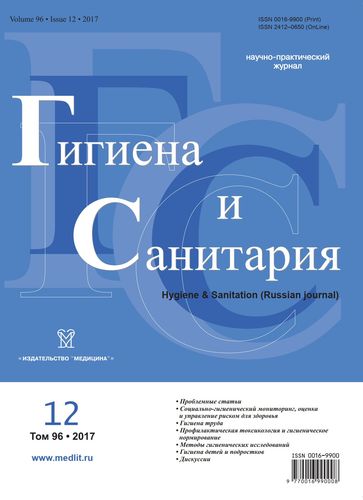Criteria for hygienic assessment of ambient air concentrations of industrial aerosols with a high content of amorphous silicon dioxide nanoparticles
- Authors: Solovyeva S.N.1, Sutunkova M.P.1, Katsnelson B.A.1
-
Affiliations:
- Ekaterinburg Medical Research Center for Prophylaxis and Health Protection in Industrial Workers, Federal Service for Surveillance on Consumer Rights Protection and Human Wellbeing
- Issue: Vol 96, No 12 (2017)
- Pages: 1179-1181
- Section: PREVENTIVE TOXICOLOGY AND HYGIENIC STANDARTIZATION
- Published: 21.10.2020
- URL: https://rjsocmed.com/0016-9900/article/view/640729
- DOI: https://doi.org/10.47470/0016-9900-2017-96-12-1179-1181
- ID: 640729
Cite item
Full Text
Abstract
The authors consider critically some inconsistencies of applying the officially established standards for inorganic dust permissible concentrations in ambient air to amorphous silica nanoparticles-containing industrial aerosols and, relying upon their previously published experimental results, propose a feasible temporary solution to this problem for the purposes of hygienic monitoring.
About the authors
S. N. Solovyeva
Ekaterinburg Medical Research Center for Prophylaxis and Health Protection in Industrial Workers, Federal Service for Surveillance on Consumer Rights Protection and Human Wellbeing
Author for correspondence.
Email: noemail@neicon.ru
Russian Federation
M. P. Sutunkova
Ekaterinburg Medical Research Center for Prophylaxis and Health Protection in Industrial Workers, Federal Service for Surveillance on Consumer Rights Protection and Human Wellbeing
Email: noemail@neicon.ru
Russian Federation
Boris A. Katsnelson
Ekaterinburg Medical Research Center for Prophylaxis and Health Protection in Industrial Workers, Federal Service for Surveillance on Consumer Rights Protection and Human Wellbeing
Email: bkaznelson@ymrc.ru
MD, PhD, DSci, Professor, Head of the Toxicology and Biological Prophylaxis Department, Ekaterinburg Medical Research Center for Prophylaxis and Health Protection in Industrial Workers, Federal Service for Surveillance on Consumer Rights Protection and Human Wellbeing, Ekaterinburg, 620014, Russian Federation.
e-mail: bkaznelson@ymrc.ru
Russian FederationReferences
- Katsnel’son B.A., Babushkina L.G., El’nichnykh L.N., Panycheva E.N., Pivnik L.Ya., Sudakova L.P. Experimental Data on Hygienic Importance of the Silica Polymorphism in Technical Stones. Gigiena truda i professional’nye zabolevaniya. 1967; (6): 35-40. (in Russian)
- Vance M.E., Kuiken T., Vejerano E.P., McGinnis S.P., Hochella M.F., Rejeski D., et al. Nanotechnology in the real world: Redeveloping the nanomaterial consumer products inventory. Beilstein J. Nanotechnol. 2015; 6: 1769-806.
- Park E.J., Park K. Oxidative stress and pro-inflammatory responses induced by silica nanoparticles in vivo and in vitro. Toxicol. Lett. 2009; 184(1): 18-25.
- Eom H.J., Choi J. Oxidative stress of silica nanoparticles in human bronchial epithelial cell, Beas-2B. Toxicol. In Vitro. 2009; 23(7): 1326-32.
- Kim Y.J., Yu M., Park H.O., Yang S.I. Comparative study of cytotoxicity, oxidative stress and genotoxicity induced by silica nanomaterials in human neuronal cell line. Mol. Cell. Toxicol. 2010; 6(4): 336-43.
- Sergent J.A., Paget V., Chevillard S. Toxicity and genotoxicity of nano-SiO2 on human epithelial intestinal HT-29 cell line. Ann. Occup. Hyg. 2012; 56(5): 622-30.
- Du Z.J., Zhao D.L., Jing L., Cui G., Jin M., Li Y., et al. Cardiovascular toxicity of different sizes amorphous silica nanoparticles in rats after intratracheal instillation. Cardiovasc. Toxicol. 2013; 13(3): 194-207.
- Petrick L., Rosenblat M., Paland N., Aviram M. Silicon dioxide nanoparticles increase macrophage atherogenicity: stimulation of cellular cytotoxicity, oxidative stress, and triglycerides accumulation. Environ. Toxicol. 2016; 31(6): 713-23.
- Guo C., Xia Y., Niu P., Jiang L., Duan J., Yu Y., et al. Silica nanoparticles induce oxidative stress, inflammation, and endothelial dysfunction in vitro via activation of the MAPK/Nrf2 pathway and nuclear factor-κB signaling. Int. J. Nanomedicine. 2015; (10): 1463-77.
- Guo C., Yang M., Jing L., Wang J., Yu Y., Li Y., et al. Amorphous silica nanoparticles trigger vascular endothelial cell injury through apoptosis and autophagy via reactive oxygen species-mediated MAPK/Bcl-2 and PI3K/Akt/mTOR signaling. Int. J. Nanomedicine. 2016; (11): 5257-76.
- Wang J., Yu Y., Lu K., Yang M., Li Y., Zhou X., et al. Silica nanoparticles induce autophagy dysfunction via lysosomal impairment and inhibition of autophagosome degradation in hepatocytes. Int. J. Nanomedicine. 2017; (12): 809-25.
- Sutunkova M.P., Solov’eva S.N., Katsnel’son B.A., Gurvich B.B., Privalova L.I., Minigalieva I.A., et al. Some peculiarities of organism’s responses to a long-term inhalation of silica-containing submicron (predominantly, nanoscale) particles of a real industrial aerosol. Toksikologicheskiy vestnik. 2017; 144(3): 17-26. (in Russian)
- Sutunkova M.P., Solovyeva S.N., Katsnelson B.A., Gurvich V.B., Privalova L. I., Minigalieva I.A., et al. A paradoxical response of the rat organism to long-term inhalation of silica-containing submicron (predominantly nanoscale) particles of a collected industrial aerosol at realistic exposure levels. Toxicology. 2017; 384: 59-68.
Supplementary files









